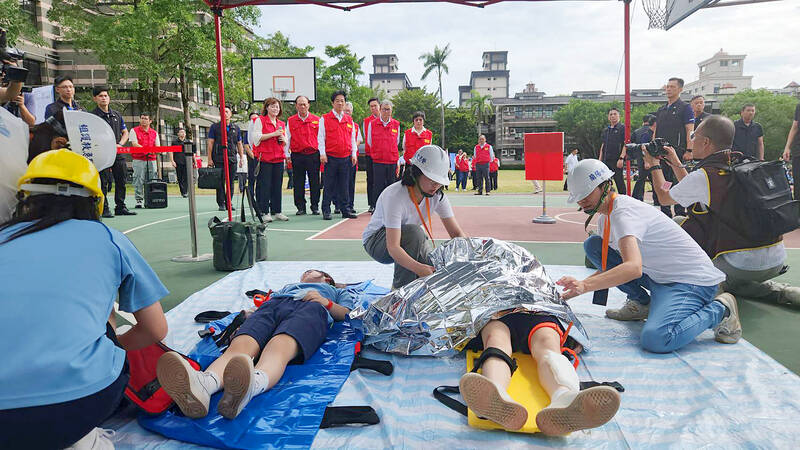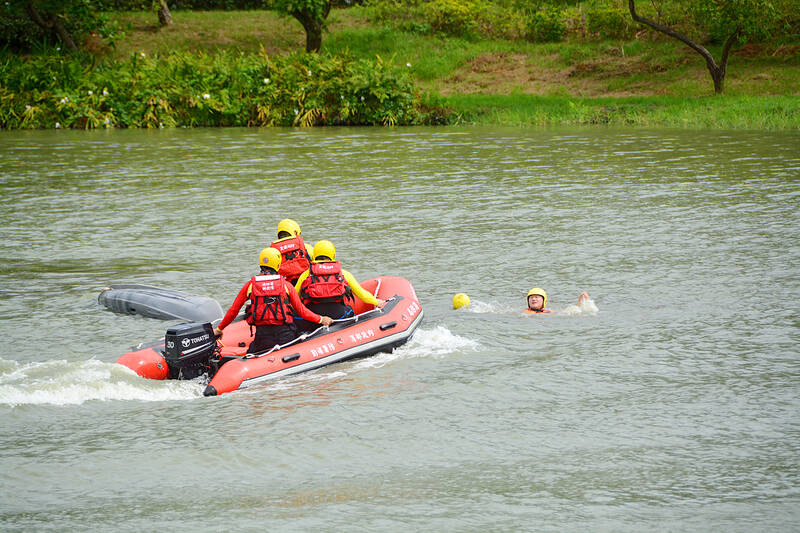Post-disaster restoration of telecom services should be as swift as the restorations of water and power supplies, President William Lai (賴清德) said as he observed disaster response drills in Yilan County yesterday.
Large-scale disaster relief drills simulating a tsunami triggered by an earthquake were held from Wednesday to yesterday in the county, with more than 1,300 people mobilized from the government, military, private businesses, non-governmental organizations and volunteer organizations.
Attendees included representatives of foreign missions in Taiwan and rescue personnel from 14 countries.

Photo: Yu Ming-chin, Taipei Times
All the drills used real-world locations and objects, and were conducted with an unscripted, semi-warning approach.
The drills simulated a tsunami caused by a magnitude 8.5 earthquake in the Ryukyu Trench, which struck the county’s Wuchieh (五結) and Jhuangwei (壯圍) townships 20 minutes later. The Yilan Sports Park (宜蘭運動公園) was the assembly point for rescue personnel.
Dozens of domestic search-and-rescue teams, along with those from the Philippines, Japan and the UK, headed to various locations, such as a quarry in Yuanshan Township (員山) or Formosa Chemicals and Fibre Corp’s (台灣化學纖維) plant at the Longte Industrial Park (龍德工業區), to carry out search-and-rescue operations.

Photo: Wang Chun-chi, Taipei Times
They not only rescued people trapped in rolled-over vehicles, but also destroyed actual buildings for search-and-rescue purposes.
Taiwan has experienced multiple disasters over the past few years, which have enhanced the public’s awareness of disaster prevention, Lai said.
The central and local governments collaborated to conduct the drills, aiming to minimize the harm from disasters and the time required for post-disaster reconstruction, he said, expressing thanks to the international community for helping Taiwan improve its disaster prevention and response capabilities.
The Whole-of-Society Defense Resilience Committee has been set up to bolster the nation’s resilience through collective efforts by people from different fields in Taiwan, Lai said.
He cited as an example a portable water purification system developed by the Buddhist Compassion Relief Tzu Chi Foundation, which could help with water demand during disasters.
As power outages caused by Typhoon Danas in Tainan and other areas disrupted telecom services in July, and the National Fire Agency has developed 5G networks jointly with the private sector, the restoration of telecom services after disasters should be stepped up in line with that of water and power supplies, Lai said.
The Ministry of National Defense’s Military Medicine Bureau has also integrated smart technologies jointly with the private sector to enable collaborations via online communications between battlefields and medical centers, he said.
The committee has commissioned the ministry to issue an all-out defense brochure that includes safety guidelines about typhoons, earthquakes and geopolitical emergencies, Lai said, adding that families would be given at least one copy.
Taiwan has achieved several milestones in disaster prevention infrastructure, such as the establishment of early warning systems for mobile phones and emergency alert systems on TVs, which help people know they need to take shelter within a short time, he said.
People are also advised to learn basic first aid skills, such as cardiopulmonary resuscitation or bandaging, to protect themselves and help others, Lai added.
Additional reporting by CNA

MISINFORMATION: The generated content tends to adopt China’s official stance, such as ‘Taiwan is currently governed by the Chinese central government,’ the NSB said Five China-developed artificial intelligence (AI) language models exhibit cybersecurity risks and content biases, an inspection conducted by the National Security Bureau (NSB) showed. The five AI tools are: DeepSeek, Doubao (豆包), Yiyan (文心一言), Tongyi (通義千問) and Yuanbao (騰訊元寶), the bureau said, advising people to remain vigilant to protect personal data privacy and corporate business secrets. The NSB said it, in accordance with the National Intelligence Services Act (國家情報工作法), has reviewed international cybersecurity reports and intelligence, and coordinated with the Ministry of Justice Investigation Bureau and the National Police Agency’s Criminal Investigation Bureau to conduct an inspection of China-made AI language

BOOST IN CONFIDENCE: The sale sends a clear message of support for Taiwan and dispels rumors that US President Donald Trump ‘sold out’ the nation, an expert said The US government on Thursday announced a possible sale to Taiwan of fighter jet parts, which was estimated to cost about US$330 million, in a move that an expert said “sends a clear message of support for Taiwan” amid fears that Washington might be wavering in its attitude toward Taipei. It was the first announcement of an arms sale to Taiwan since US President Donald Trump returned to the White House earlier this year. The proposed package includes non-standard components, spare and repair parts, consumables and accessories, as well repair and return support for the F-16, C-130 and Indigenous Defense Fighter aircraft,

CHECKING BOUNDARIES: China wants to disrupt solidarity among democracies and test their red lines, but it is instead pushing nations to become more united, an expert said The US Department of State on Friday expressed deep concern over a Chinese public security agency’s investigation into Legislator Puma Shen (沈伯洋) for “secession.” “China’s actions threaten free speech and erode norms that have underpinned the cross-strait ‘status quo’ for decades,” a US Department of State spokesperson said. The Chongqing Municipal Public Security Bureau late last month listed Shen as “wanted” and launched an investigation into alleged “secession-related” criminal activities, including his founding of the Kuma Academy, a civil defense organization that prepares people for an invasion by China. The spokesperson said that the US was “deeply concerned” about the bureau investigating Shen

‘TROUBLEMAKER’: Most countries believe that it is China — rather than Taiwan — that is undermining regional peace and stability with its coercive tactics, the president said China should restrain itself and refrain from being a troublemaker that sabotages peace and stability in the Indo-Pacific region, President William Lai (賴清德) said yesterday. Lai made the remarks after China Coast Guard vessels sailed into disputed waters off the Senkaku Islands — known as the Diaoyutai Islands (釣魚台) in Taiwan — following a remark Japanese Prime Minister Sanae Takaichi made regarding Taiwan. Takaichi during a parliamentary session on Nov. 7 said that a “Taiwan contingency” involving a Chinese naval blockade could qualify as a “survival-threatening situation” for Japan, and trigger Tokyo’s deployment of its military for defense. Asked about the escalating tensions